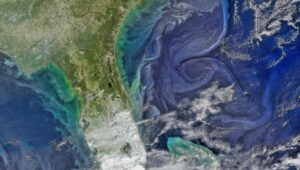Raytheon wins NOAA study contract for geostationary imager
By Debra Werner

SAN FRANCISCO – Raytheon won a National Oceanic and Atmospheric Administration contract for a design study of Real Time Imager (RTI), an instrument to obtain high-resolution Earth observation imagery from geostationary orbit.
NOAA awarded Raytheon Intelligence & Space a $413,088 contract in April to spend six months assessing an approach called step-and-stare imaging.
Unlike the Advanced Baseline Imager on NOAA’s Geostationary Operational Environmental Satellite-R (GOES-R) series, which captures imagery by continually scanning scenes, RTI is designed to stare at an area larger than 1,000 kilometers by 1,000 kilometers before focusing on another area. The next areas of focus can be adjacent to the previous one or across the globe.
“By staring we get much better sensitivity,” Jeff Puschell, Space Systems principal engineering fellow for Raytheon Intelligence & Space, told SpaceNews. “With our rather large footprint, we cover the entire Earth very efficiently.”
The Raytheon award is one of a series of contracts NOAA is issuing to investigate potential instruments, spacecraft, business models and mission concepts for the space-based architecture to succeed the Joint Polar Satellite System and GOES-R series.
As of June 2, NOAA had awarded 26 contracts for analyses of instrument and mission concepts. Fourteen of the contracts fund studies related to geostationary and extended orbits. Another 12 fund studies focused on low Earth orbit sounding.
Raytheon is assessing various approaches to RTI, including evaluating the merits of cooled and uncooled infrared detectors.
“One advantage of a step-and-stare architecture is its efficiency,” Puschell said. “We can cover the earth quickly with uncool infrared technology based on microbolometers.” (Microbolometers are devices used to measure electromagnetic radiation.)
For the NOAA study, Raytheon draws on a microbolometer array the firm developed and space-qualified for the Europa Thermal Emission Imaging System, which the company is producing for the Europa Clipper mission. The uncooled instrument could meet “almost all of the objective level requirements” for a new imager in addition to a day-night band, Puschell said, adding the technology would significantly reduce spacecraft power consumption.
Raytheon also is touting RTI’s speed in gathering and downlinking data.
“We transmit the data from the previous stare during the current stare,” Puschell said. “We start collecting data on the next location while we’re transmitting the data we’ve already collected. That gives us relatively short latency.”
The exact latency will depend on RTI’s spectral band combination and downlink speeds. RTI “can have up to 32 spectral bands and as few as four,” Puschell said. “NOAA is asking us to look at how latency varies with the number of spectral bands.”
In addition to the Europa mission, RTI draws on technology Raytheon developed for the Joint Polar Satellite System Visible Infrared Imaging Radiometer Suite (VIIRS).
“The spectral bands that we use in RTI are very similar to VIIRS, including the day-night band,” Puschell said. However, Raytheon updated the technology because NOAA is demanding higher spatial resolution for its next-generation geostationary imaging instrument.
June 4, 2020 at 11:03PM
via SpaceNews.com read more...

Post a Comment